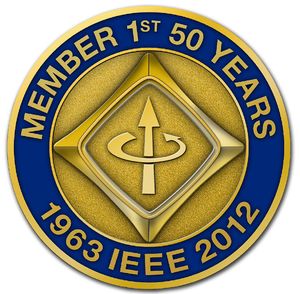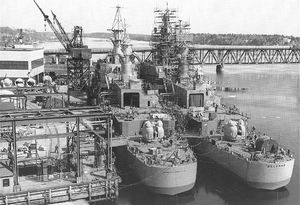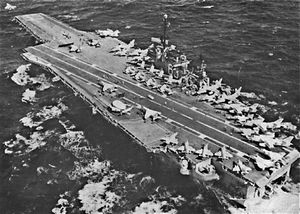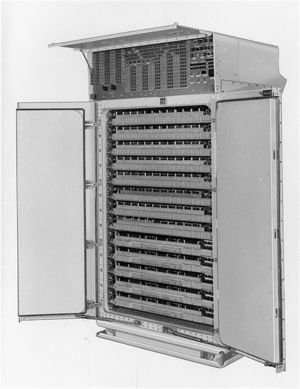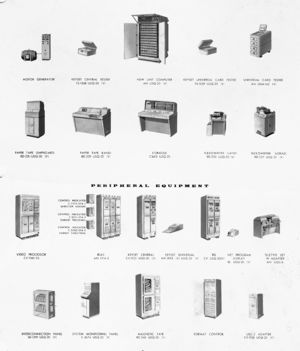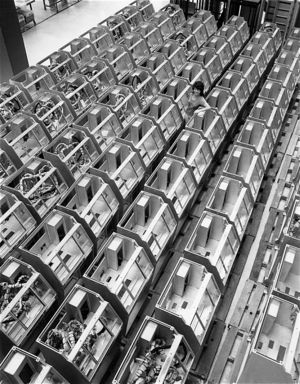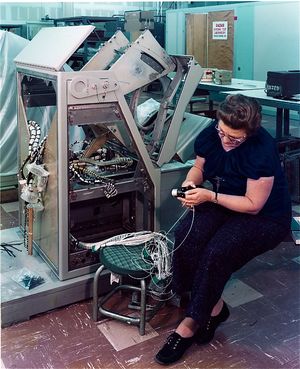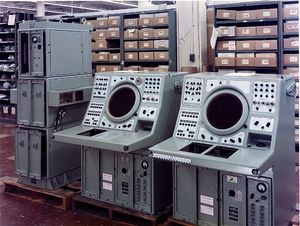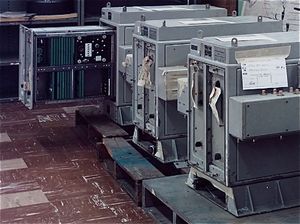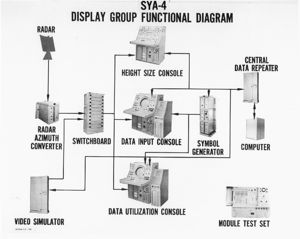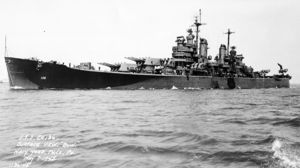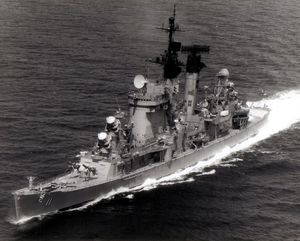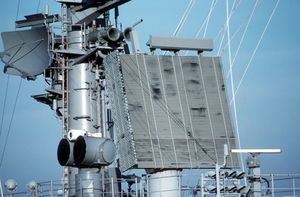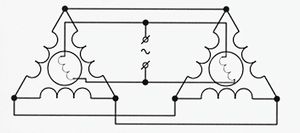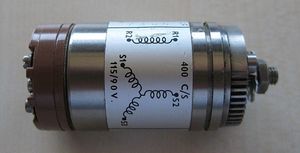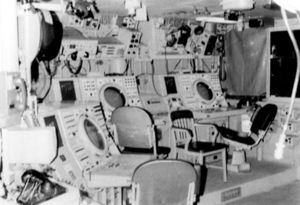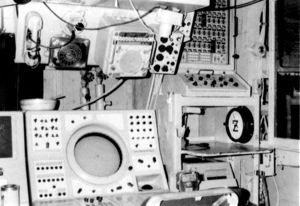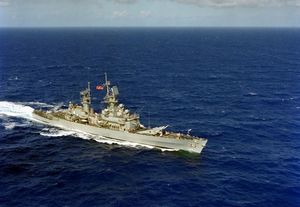First-Hand:Moving the Firing Key to NTDS - Chapter 6 of the Story of the Naval Tactical Data System
By David L. Boslaugh, Capt. USN, Retired
The Last of the Warriors
Let us start by setting the clock back to May 1961. The three NTDS service test ships had been in shipyards for three months, undergoing installation of a new 'command and control system' that most of its potential customers did not want. Commander Joe Stoutenburgh was on an airliner over the Pacific, bound for Hawaii. The Commander in Chief, Pacific Fleet and his senior staff had been hearing rumors about NTDS and had asked for a briefing addressing these negative charges. CINCPACFLEET was concerned he was going to get his three service test ships back much later than scheduled, and when he did, there were whispers that they would have to go back into the yards to have the digital systems ripped out.
Electronics reliability experts had told staff officers that the new system was so complex, with such a high parts count, that it could not possibly work for more than a few minutes without equipment failure. Other detractors had said that the NTDS ships would not be able to operate with conventionally equipped ships, and others had warned that when the digital system failed, the combat information centers would not be able to operate at all. Thus their concern that even more time would be needed to have the systems removed.
Stoutenburgh went over the reliability issue first. He informed them that the engineering test equipment at the Navy Electronics Lab had been amazingly reliable with very few failures. Furthermore the new enlisted data system technicians had become very adept at quick equipment failure diagnosis, repair and system restoration. The normal repair time for the rare equipment malfunctions was about 15 minutes. Next the system failure and interoperability concerns. He advised them that even if there were no computer system at all, the NTDS consoles were built to work as normal radar repeaters and the ships had full suites of normal task force tactical voice communication circuits and could thus interoperate with any conventionally equipped ship. Furthermore, the CICs would still be equipped with conventional plotting boards, status boards. and vertical summary plots.
Stoutenburgh told them to be ready to get their ships back on schedule, and by the way, there was no chance that the systems would have to be ripped out. One of the senior staff officers than asked, “Well what about all these negative rumors, surely you must have some concerns about the system?” Stoutenburgh thought for a moment and thought to himself, “These people don't write my fitness report,and I really don’t care if I get them mad at me.” He said, “Yes I do have a concern.” They leaned forward expectantly, thinking, “Aha, at last, it comes out.” He said, “My main concern is that your heavy combatants don’t stand a chance against a massed Soviet air attack. What are you going to do, keep them tied up to their piers until they get NTDS?”
Then Stoutenburgh stood by for what he thought would be their angry rejoinders. But, instead, one of the staff officers rather quietly said, “OK, when are our heavies going to get NTDS?” He replied,”At this point OPNAV has told us to start thinking about a first production run to equip 15 to 18 high-priority ships. Ten of these will probably be new-construction guided missile frigates, and the remainder will be existing heavy cruisers and aircraft carriers that are equipped with guided missile systems. After that all attack carriers and all new construction combatant ships from guided missile frigate on up will get the system.” Nine months later, even though NTDS was still in service test, OPNAV told the Bureau of Ships to order the equipment for 17 ships. [Stoutenburgh, Capt. Joseph S., Letter to D. L. Boslaugh, 5 Jan 1988]
These first 17 were:
USS Bainbridge (DLGN 25), a nuclear powered guided missile frigate to get the system during its first shipyard overhaul.
Nine Belknap Class (DLG -26 through 34) guided missile frigates - under construction.
The nuclear powered guided missile frigate Truxton (DLGN 35) - under construction.
Three attack carriers having high priority because they carried Terrier missile batteries: USS America, USS Kitty Hawk, and USS Constellation.
Three heavy cruisers that had been converted to guided missile cruisers with Talos missiles fore and aft, and Tartar batteries on each side amidships:Chicago, Albany, and Columbus. These three would be the only World War II veterans to get NTDS - the last of the warriors. [ Bureau of Ships, NTDS Project Office, NTDS ship systems procurement tables, 1967]
A Few More Improvements, First-Production NTDS Equipment
The unit computer’s maintenance and control panels, with the myriad's of miniature flashing lights, had been envisioned to be used mainly for equipment trouble shooting and maintenance and would be resorted to only infrequently. It was not thought that having the panels inside the computer’s front doors would cause cooling problems. During service test, however, it had been necessary to open the doors a number of times per day, and to keep them open sometimes for hours to troubleshoot computer program problems.
This practice of running the computers with doors opened greatly interfered with cooling of the electronics, and in the long run the excessive heat in some spots it could shorten the affected electronics' life. The major change made to the unit computer was to relocate the maintenance and control panels to the top of the computer to allow the doors to remain closed. With this change the new unit computer was redesignated CP-642A. The service test ship CP-642 unit computers were eventually upgraded by field changes to move the control panels to their tops also. Five months after completion of service test, Univac was delivering the new unit computers to shipyards. In all, 360 CP-642 series computers were built. [Bureau of Ships, Technical Development Plan for the Naval Tactical Data System (NTDS)-SS 191, 1 Apr. 1964]
The tactical data link equipment fared as well in service test as it had in engineering test, and very few changes were needed. BUSHIPS placed an order with Collins Radio for 17 shipboard suites of AN/SRC-16 HF radios and 22 AN/SSQ-29 modems. [Collins Radio Company, Table 4.1.1.3.5-1 NTDS/MTDS/ATDS Collins Activity 1955-1976, undated] All of the first-production NTDS ships were equipped with surface missile systems, and
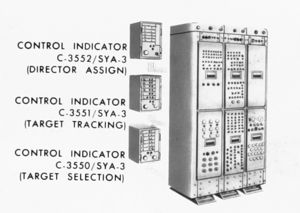
needed a way to send high priority NTDS targets to the missile weapons direction systems. Univac was thus contracted by the Bureau of Naval weapons to supply seventeen Interconnecting Digital to Analog Converters (IDACs). The first three IDACs were to interface NTDS with the Tartar and Talos missile batteries in the three converted cruisers Albany, Chicago, and Columbus via their Mark 6 Weapons Direction System. The next three were to work with the Terrier missile systems in the attack carriers: America, Constellation and Kitty Hawk. The final eleven were to interface with the Terrier missile systems in eleven guided missile frigates. [Bureau of Ships, NTDS Project Office, Naval Tactical Data System Nomenclature List, undated, p 11]
The NTDS project was still concerned about the high cost of the Hughes display subsystem, and most of the changes from service test equipment to first-production were 'value engineering' changes to bring down cost. The only substantial change was the addition of decimal numbers to the symbol generator's repertoire so that quantities such as target course and speed could be written on the radar scopes. The first-production display subsystem was redesignated AN/SYA-4.
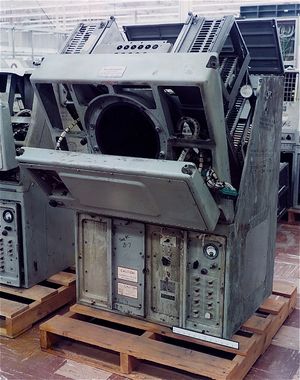
The World War II heavy cruiser Chicago had entered the San Francisco Naval Shipyard in July 1959 to begin its conversion to guided missile cruiser. The conversion was scheduled to take 4 1/2 years, ending in December 1963, giving time to install first-production NTDS, and made Chicago the first ship to carry a production suite of NTDS equipment.
Before we review how the missile firing key was moved to the Naval tactical Data System, it would be best to tell first of another companion development to NTDS - undertaken by the BUSHIPS Radar Branch.
The AN/SPS-48 Radar
The reader may recall from Chapter 4 that just before he retired from the Navy, Commander Irvin McNally met with Radar Branch engineers to work out the specifications for two new radars that were to work with the Naval Tactical Data System. One was a long range two-dimensional air search radar, and the second was to be a three-dimensional, height finding air search radar having unusual range and unusual accuracy, but with the fast rotation rate of a conventional two-dimensional radar. A hard specification to fulfill. The Radar Branch had sent a new height finding radar to sea in 1958 that they hoped would fulfill these requirements. but this new AN/SPS-39 radar had been found wanting.
There were two primary users of shipboard three-dimensional radars: air intercept controllers and anti-aircraft gun & missile fire control systems. The AA fire control pencil beam radars needed to be pointed fairly precisely at a new air target because of their narrow, but very accurate, beams. If not pointed precisely they wasted precious time running a pattern searching for the new target. The A A fire control systems could live with search radar detection ranges between 100 and 50 miles (depending on weapon range), but they wanted fast search radar scan rates, as short as four seconds per rotation, in order to catch new incoming low fliers. On the other hand, the air intercept controllers wanted ranges out to 200 miles or more, but could live with much slower scan rates.
The AN/SPS-39 rotated mechanically in azimuth and scanned up to 45 degrees in elevation by varying the operating frequency. To get solid elevation coverage with good accuracy almost 100 pulses were needed for each elevation scan, with a few hundred of these vertical scans per antenna revolution. Many thousands of outgoing pulses were thus needed for each rotation in azimuth. The problem was the physical limitation of the velocity of light did not allow the radar to provide full elevation coverage at 200 mile ranges at four second azimuth scan rate. The radar could be set up to serve the AA systems well, with high rotation rate and short range. Or it could be set to serve the air intercept controllers well with low rotation rate and long range, but it could not do both at the same time. When users tried to optimize the SPS-39 to serve both functions, the 100 mile range of the newer Talos guided missiles became a particular problem. A more capable three dimensional radar was clearly needed. [Inman, Capt. Bryce D., Letter to D. L. Boslaugh, 15 Aug. 1995]
In 1960 the Office of the Chief of Naval Operations told the BUSHIPS Radar Branch to begin developing a follow-on to the SPS-39 for use aboard both NTDS and non-NTDS equipped ships. In particular the new radar was to provide antenna azimuth to NTDS directly in digital format, and it was to be upgradable to automatic target detection and tracking as soon as technology allowed. In charge of the BUREAU’s three dimensional radar group, Mr. George Greenwood pulled out of his file the four-year old specification for a 3-D radar that the Radar Branch and Cdr. McNally had drawn up in 1956, and wrote a few pages of updates and refinements. Then he turned it over to his young assistant, Donald C. Bailey, telling him this would be his work for the next few years.
It was going to be a tough project. The radar had to satisfy both the air intercept controllers and the AA fire control systems at all times with no optimization for one or the other. It had to have a four-second azimuth scan rate to satisfy the AA systems, and at the same time it had to have maximum detection range over 200 miles for the intercept controllers. Furthermore, it had to have unprecedented accuracy in handing targets over to the AA fire control radars - as far out as 100+ miles for the Talos missile system. And, it had to be capable of generating many thousands outgoing pulses in one four second sweep. It clearly needed some radio frequency power generator of a new technology that Bailey was not yet aware of.
Bailey reworked the specification into a detailed request for proposals that he sent out to the U. S. radar industry in May 1960. He got back 12 responses, two each of which he issued to each member of his six-man (including Bailey) proposal review team, all of whom were radar engineers in other parts of the Radar Branch. Each member was to review and analyze his two proposals in detail and present them to the review group. A small Los Angeles-based company named Gilfillan Corporation had sent in one of Bailey’s two proposals. They had never built a shipboard radar, in fact their forte was ground based ground control approach radars for the Air Force. But the review group became interested in a number of ingenious aspects of their proposal; in particular how they proposed to use a new power tube called an ‘amplitron.’ [Bailey, Donald L., Interview with D. L. Boslaugh, 22 Oct. 1994]
As with the AN/SPS-39 radar Gilfillan proposed mechanical scanning by rotation in azimuth and frequency scanning in elevation - by feeding the antenna elements with a serpentine wave guide. But, with their rapidly tunable amplitron power tube they said they could cover six degrees of elevation scan with a single outgoing pulse. This would be done by ‘chirping’ the pulse upward in nine different frequency steps so that each of the nine steps left the antenna at a different ‘squint’ angle from the preceding frequency step. A full height scan up to 48 degrees would be done by only eight outgoing pulses. [Inman]
On paper, it looked like the Gilfillan scheme would work, but the proposal had a number of other equally advanced and risky features. The team asked Gilfillan to send their engineers to Washington for further discussions. Once in Washington Bailey took the Gilfillan engineers over to the Naval Research Laboratory where he arranged for Dr. Robert M. Page, chief inventor of American naval radar, and his engineers to give them an intense interrogation. The Gilfillan engineers held up under the onslaught and came up with believable answers for each question; in particular how they would ameliorate the technical risks. Dr. Page’s engineers and the review team was swayed, and in June 1960 BUSHIPS issued Gilfillan a contract to begin developing the new AN/SPS-48 radar.
Gilfillan Corporation had the prototype SPS-48 ready for at-sea operational evaluation by early 1962. As with many new systems, the OPEVAL showed that when the new radar worked, it worked very well, but it had a number of reliability problems. The amplitron power tube was cooled by water flowing through very small cooling passages, and fine particles in the cooling water plugged them up; causing tube failure with distressing regularity. Bailey got a large collection of failed amplitrons, and finally had to install a water still on the test ship to get very pure coolant. The digital shaft position encoder, meant to provide binary antenna azimuth information to NTDS failed on average every 50 hours because the miniature light bulbs used in the encoders kept burning out. To add to the problems the antenna rotation drive motors occasionally burn out.
Senior research and development funds managers in the office of the Secretary of the Navy who were aware of the high technical risks inherent in the SPS-48 technology got wind of the SPS-48 problems. They decided that further effort on the new high tech project would be a waste of funds. Bailey was thus put in the position of spending more time briefing senior SECNAV staffers and defending his funds than in working on corrections. Fortunately, the Chief of the Bureau of Ships, Radm. Ralph K. James appreciated the pressing need for the new radar and put up a strong defense of the project which resulted in stabilizing the funding so that Bailey could continue working on technical issues.
Bailey next set up a contract with the Bell Telephone Laboratories Reliability Group who studied the radar and devised fixes to cure the reliability problems. Further testing of the prototype after the fixes showed that Bell Labs had done its work exceedingly well. In early 1963, the Radar Branch contracted with Gilfillan Corp. for a limited AN/SPS-48 production run incorporating the reliability fixes.( To vindicate those who struggled to keep the project alive. The AN/SPS-48 radar in its fourth variant still serves in the fleet five decades later, with detection ranges approaching 250 statute miles, improved accuracy, and fully automatic target detection and tracking.) [Bailey] [AN/SPS-48 From Wikipedia, the free encyclopedia]
The surface missile systems: Tartar, Terrier, and Talos, had also had their own reliability and performance problems over the years, so much so that in late 1962 the Secretary of the Navy elected to move all of the disparate groups who were providing subsystems and components for the missile systems under a single manager in a new Surface Missile Systems Project Office. Rear Admiral Eli T. Reich was assigned as the first SMS project manager, and his authority extended, to a certain extent, even to development projects in the Bureau of Ships if their systems impacted the performance of the surface missile systems. His authority in these cases included project review and the issuance of funded tasks. Shipboard search radar developments and the Naval Tactical Data System fell into this category. [Surface Missile Systems Project Office Brochure, The SMS Fleet, 15 Feb. 1965]
In late 1962 Radm. Reich made a phone call to Radm. Ralph K. James, the Chief of the Bureau of Ships. He told James that he had heard about the AN/SPS-48 operational evaluation problems and he wanted to arrange a ‘one-on-one’ briefing by its immediate project manager. He emphasized he wanted no one else at the briefing. Baileys bosses notified him to get ready for the briefing; and Bailey’s first thought was, “Here we go again, another six thousand pound gorilla is out to terminate my project.” Anticipating the worst, he called Reich’s office to arrange the briefing. We will come back to this story again. [Bailey]
Moving the Firing Key
We have already reviewed how high-priority target information was passed from NTDS to the shipboard missile and gun weapons direction systems (WDS) in the service test and early production NTDS ships. The WDS usually had three track entry consoles fed from the same search radars that fed NTDS, further they had consoles for a fire control system coordinator and a missile system engagement controller. The FCS coordinator assigned targets to missile and gun fire control systems, and the engagement controller gave commands to load missiles onto their launchers and fired the missiles. Separate equipment cabinets contained the analog target tracking channels, usually eight in number. This equipment was located in the weapons control area of the combat information center.
There was clearly some redundancy between NTDS and the weapons direction systems, but originally, with the unproved status of NTDS, this conservative arrangement was considered the best way to introduce NTDS without the concern of compromising weapons control capability. In early 1960, as confidence grew in NTDS, the NTDS project officers began to question the need for the redundant arrangement, and Lcdr. Joe Stoutenburgh took on an extracurricular task to work out if, and how, the weapons direction function could be absorbed into NTDS. If the WDS function could be worked into NTDS it seemed that there could be considerable savings in equipment, with their accompanying manning, weight, space, power, and cooling requirements, not to mention a shortening of reaction time in passing high threat targets to the fire control systems. A few seconds in reaction time could be very important in battle.
As Stoutenburgh studied the problem he could see that his quest was not going to be a simple one-for-one tradeoff. The WDS analog circuitry and banks of logic circuits did a number of functions that would have to be added to NTDS capabilities. These included: 1. not only calculating whether a missile from the ship could intercept a selected target, but also showing when and where, 2. running through a routine of complex engagement logic, 3. monitoring and displaying a number of pre and post firing conditions in the missile system, 4. running a continuous safety check on missile systems and flagging unsafe conditions, and 5. assessing the results of the engagement.
Lieutenant Commander Joseph L. Randolph, an engineering duty officer, had graduated from the electronics engineering masters program of the U. S. Naval Postgraduate School in the spring of 1959. Like most junior project officer inductees to the NTDS project, he was assigned to the BUSHIPS Technical Representative’s (BSTR) office (the former Naval Computing Machine Laboratory) at the Univac plant in St. Paul for a year of indoctrination and technical tasks before moving on to the Bureau project office. A few months into 1960, Cdr. Svendsen and Lcdr. Stoutenburgh asked Randolph if he would be interested in working out the details of moving the Terrier system WDS function into NTDS. He assented, and this started a few months of intense study and investigation. The first target of his efforts would be the Terrier missile systems in the Belknap (DLG 26) Class guided missile frigates now on the building ways. [O’Sullivan, William C., Interview with D. L. Boslaugh, 15 Oct. 1994]
Fortunately, the Terrier missile magazine equipment and launching system were being built by Northern Ordnance Corporation located in Minneapolis, only a short drive from the BSTR office, and Randolph began his studies there. Then he traveled to Ford Instrument Company, the maker of the Mark 119 Terrier system analog fire control computer, on Long Island where he digested volumes of technical manuals and engineering reports, and then on to do the same at Western Electric Company, the manufacturer of weapons direction systems designed by Bell Labs. Then came visits to Bureau of Naval Weapons (BUWEPS) activities and discussions with their engineers.
After a few months Randolph had developed a detailed description of the weapons direction function, along with specifications for two new items of NTDS equipment that would be required to carry out the function. These were a fire control data converter (FCDC) to take the place of the interconnecting digital to analog converter (IDAC), and a weapons control panel. The new FCDC would connect between an NTDS computer and the missile and gun fire control computers, and it would convert numerical information in both directions as well as pass control and status signals in both directions. For example it would send range, bearing, and elevation voltage signals of an assigned target to a fire control computer which would then slew out its pencil beam radar director to acquire the target. Once acquired, the fire control computer would send back the radar target coordinates for display on an NTDS console. The fire control computer would also send to NTDS such numerical information as the fire control computer’s coordinates of predicted target impact point and recommended time to firing.
The new weapons control panel would serve to connect the missile system engagement controller, seated at an NTDS console, to the missile magazine and launching system. From the panel the engagement controller would be able to select missile types, load launchers, and fire missiles. Yes, the firing key would be moved to a piece of NTDS equipment. The panel would also show numerous status signals back from the magazine and launcher, such as ‘missile on rail’ and ‘ready to fire.’
Randolph met next with Univac programmers and went over his weapons direction function description with them. He had two questions: how small a computer program module could they devise to perform all the functions, and where could they boil down the existing guided missile frigate computer program to free up enough memory to support the new module. After a few weeks they came up with answers to both; they were pretty sure it could be done. [Mahinske, Capt. Edmund B., Letter to D. L. Boslaugh, 19 July 1994]
The Ships Characteristics Board (SCB) in the Office of the Chief of Naval Operations makes the decisions regarding what weapons and sensor systems, among other things, will go aboard new ship classes. In May 1960 Commander Joe Stoutenburgh appeared before the SCB and proposed that the weapons direction function me merged into the Naval Tactical Data System in future Terrier and Tartar missile ships. (The Navy planned to acquire no more of the long range Talos missile systems.) Stoutenburgh used the two service test guided missile frigates as his example, and he showed how in those ships five weapon direction system consoles, six refrigerator sized equipment cabinets, and the interconnecting digital to analog converter could be replaced by two NTDS consoles, a new weapons control panel, and a new fire control data converter.
Stoutenburgh showed the Board that 7000 pounds of high topside equipment could be eliminated which would free up 300 cubic feet of equipment space. Furthermore a requirement for two general quarters personnel could be eliminated. The members of the SCB were impressed and approved the change; but with one proviso, the new computer program module must fit into the existing NTDS computers. OPNAV obtained the designation Weapons Direction System Mark 11 for the new configuration, and directed that it was to be installed beginning with the fourth ship of the Terrier equipped DLG-26 guided missile frigate class as well as the nuclear powered frigates Truxton and Bainbridge. The first Tartar missile system application of WDS Mk 11 was to be in the Carrier John F. Kennedy who’s construction start was scheduled for 1964. The Board also directed that the new AN/SPS-48 three dimensional search radar would be installed concurrently with WDS Mk 11. [Bureau of Ships, NTDS Project Office, Unsigned point paper on the development of WDS Mark 11, Dated 1967] [Moore, Capt. John R., Editor, Janes American Fighting Ships of the 20th Century, Mallard Press, New York, 1991, ISBN 0-94-7924-5626-2, p 150]
Lcdr. Joe Randolph’s work was cut out for him for the next five years. It was generally known that the NTDS computer memories were loaded to the maximum. There were many in both BUSHIPS and BUWEPS who did not see how Randolph was going to be able to shoehorn the WDS Mk 11 module onto the already loaded guided missile frigate program. In BUWEPS, added to legitimate doubts, was a growing feeling of resentment and anger that the Bureau of Ships was taking over what had always been a BUWEPS function. There is even a legend that when one long time BUWEPS engineer learned that the missile firing key was to be moved to a piece of NTDS equipment’ he put in his retirement papers. Other BUWEPS officers demanded that Randolph put in writing a letter to the Chiefs of of the Bureaus of Ships and Naval Weapons, that if he failed in his endeavor, he would resign his Navy commission. Randolph called their bluff and sent the letter. [Mahinske, Capt. Edmund B., Letter to D. L. Boslaugh, 19 July 1994]
The first order of business for Randolph was to prepare contract specifications for the new fire control data converter, the weapons control panel, and the new computer program module. Concurrently there were task statements to be written for BUSHIPS and BUWEPS ship installation engineers to work out the details of shipboard wiring runs from the fire control data converter to the weapons fire control system switchboards, and attendant switchboard changes, so that the FCDC could interchange data directly with the analog fire control computers. Similar task statements were needed to connect the weapons control panel with the missile magazines and launchers.
In the summer of 1960 the Bureau of Ships issued a contract to the Univac Division at St. Paul to build fire control data converters and weapons control panels for eight guided missile frigates and the Carrier John F. Kennedy. The contract also called for developing the new computer program module. Univac decided to build the weapons control panel at their St. Paul plant, but elected to subcontract the FCDC to Ford Instrument Company who was also a part of the Sperry Rand corporate organization. Ford Instruments was the designer and builder of the Terrier missile system’s Mark 119 analog fire control computer, an extremely complex combination of electronics and electromechanical devices, and thus knew the analog conversion requirements of the fire control data converter very well.
Where the Hell is Myer’s Island?
The U. S. Naval Schools Command located in the Mare Island Naval Shipyard at Vallejo, California already had working Terrier and Tartar fire control systems, complete with fire control radars. Furthermore the NTDS maintenance school was located about a hundred yards from the fire control system school. It was a perfect location to set up a combined WDS Mark 11 and SPS-48 radar test site. Furthermore, when testing was done, the equipment could be turned over to the school for training use.
We have related how in late 1962, Radm. Eli T. Reich, director of the new Navy Surface Missiles Project Office, asked the Chief of the Bureau of Ships to send Mr. Don Bailey, the SPS-48 project manager, over for a one-on-one meeting with him. Bailey’s main concern was he was again going to have to defend his project against another senior official who was out to kill it. The beginning of the discussion validated Bailey’s concerns. Reich wanted to know about every problem Bailey had during the radar’s operational evaluation, and what he was doing about each one. Then he interrogated Bailey on the details of his development schedule. But next he asked Bailey a very strange question.
The admiral wanted to know what support and resources he would need from the SMS Project Office to accelerate his schedule by eleven months. Bailey was astounded and confessed he had come over expecting to engage in battle one more time to keep his project going. Reich replied, “hell no.” He was unhappy with the performance of the AN/SPS-39 radar and wanted to get the SPS-48 teamed up with the surface missile systems as soon as possible. More specifically, he wanted to install the SPS-48 and WDS Mk 11 in the third ship of the DLG-26 Class rather than wait for the fourth ship. The third ship was Wainwright, due to be commissioned in or about January 1966, and the fourth ship was Jouett, due to be commissioned in or about December 1966.
Bailey responded that with more resources and the general support of the SMS project office he could probably shrink the schedule by the requisite 11 months. Radm. Reich was a no nonsense man of action, and he did not want Bailey to get back to him with the details of a new schedule, he wanted to start working out a new schedule right there and now. When that was done he asked bailey to give his best estimate of the additional funding and other SMS project help he would need to achieve the new schedule.
A few days later Radm. Reich had another one-on-one meeting with another project manager, this time Lcdr. Joe Randolph, and he asked him the same questions, this time about WDS Mark 11. Randolph also agreed that with additional funds and the support of the SMS project he could meet the same schedule. Armed with the new schedules, Reich convinced OPNAV that the SPS-48 and WDS-Mark 11 could be installed first in Wainwright, and her ship’s characteristics were thus amended. [Foreman, Capt. Robert P., Interview with D. L. Boslaugh, 8 Sept. 1994]
By mid 1962 the at-sea service test of NTDS was over and Lcdr. James E. Radja, the NTDS trouble shooter at the Navy Electronics Lab, noted his workload was beginning to slack off. This didn’t last long. He soon received orders to report to the Schools Command at Mare Island to build and manage the WDS Mk 11 and SPS-48 radar test site. He would have a team of engineers from Ford Instrument Co., Raytheon Corp. (the builder of the Terrier system’s AN/SPG-55 fire control radar) Gilfillan Corp. (builder of the AN/SPS 48), and Univac, as well as Navy civilian engineers and enlisted personnel to help him. By June 1963 the team had the new prototype radar and the NTDS equipment up, running. and ready for test. [Bureau of Ships, Technical Development Plan for the Naval Tactical Data System (NTDS)-SS 191, 1 Apr. 1964]
This writer’s main assignment as an assistant NTDS project officer was the development of a series of automated tests using the unit computer as the main testing tool. These ranged from equipment fault isolation maintenance tests, to system calibration and alignment tests, to overall system operational readiness tests. The system alignment tests would include tests where live aircraft were tracked simultaneously with search and fire control radars to measure misalignments among the radars. These were to be conducted using a special testing program in the unit computer that would record the radar inputs and calculate, display, and printout alignment errors in real time as an aircraft circled the ship. The operational readiness tests were to use a modified NTDS operational program with data extraction capabilities to record the events and geometry of such evolutions as missile firings and air intercepts.
The primary instrumentation for the calibration and alignment and operational readiness tests was to be the guided missle frigates two Terrier system fire control radars with their very accurate range, bearing and elevation measurement capability. For intercept control tests one fire control radar would be locked on to the interceptor and the other locked on to the target aircraft to yield a very accurate reconstruction of the intercept geometry. Similarly in missile firing tests one radar would track the target aircraft (as it normally would) and the other would be locked on to the missile soon after firing to reconstruct the intercept geometry.
Univac was contracted to write the requisite computer programs, and when written the programs were to be validated at the Mare Island test site. After validation the programs were to be used to help test the performance of WDS Mark 11 and the SPS-48 radar at the site. After that the programs were to be delivered to the DLG 26 Class missile frigates for use in ships company qualification training and general readiness testing use.
The first problem in developing the testing programs was with our own NTDS equipment. The keyset central unit had inputs for only eight two-speed synchro inputs, and four were already in use to provide ships roll, pitch, heading and speed inputs to the unit computer. We wanted to also input range, bearing, and elevation from both fire control radars at the same time, a total of six more inputs.
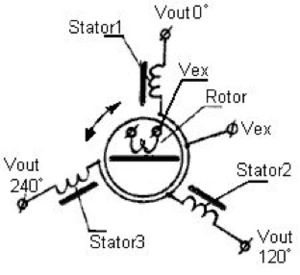
A synchro system consists of a transmitter and a receiver that look like two small electric motors. The transmitting synchro uses three wires to send voltages that vary depending on the position of the rotor in the transmitter, and the receiving synchro sets up magnetic fields that locks the rotor in the receiver in the same position as the transmitting synchro’s rotor. When the transmitter’s rotor is turned it causes the receiver’s rotor to turn in synchronism with it. A further refinement was called a two-speed synchro wherein a gearing arrangement turned a second synchro transmitter through a full revolution every time the primary transmitter turned ten degrees. The secondary synchro thus served as a kind of vernier and made for very accurate signal transmission. In the early 1960s synchros were the primary means of sending accurate scaled voltage signals around a ship. They were used to send position commands to large mechanical devices such as gun turrets, missile launchers and radar directors. Missile fire control systems used synchros in abundance.
We reviewed the keyset central technical manual and found that though it had eight synchro input channels, it had only one electronic synchro to digital converter, and that the eight channels were multiplexed through it, one at a time. We also noted that the multiplexer worked at electronic speeds and that it was theoretically possible to multiplex many more of relatively slowly changing synchro inputs through the converter. The Ford Instrument Co. engineers at the Mare Island test site set up an experiment for us. With clip leads into the missile fire control switchboards they brought out the range, bearing and elevation synchro signals from both the Tartar and Terrier fire control radar directors. Then with a simple manual switch they switched back and forth between the two sets of inputs and fed three of the unused synchro input channels of our keyset central. It worked!, we could input the signals from both directors simultaneously - for our practical purposes. The next hurdle was to get permission to install a computer controlled multiplexing switch in the Mare Island missile fire control switchboard, and if that worked to get permission to modify the fire control switchboards that were to be installed in nine guided missile frigates.
Commander Wayne E. Meyer in the Terrier Office of the SMS project was the ‘owner’ of the switchboards. In previous sea tours he had been electronics officer, CIC officer, fighter director officer, as well as executive officer of a destroyer escort. Before assignment to the SMS project had been fire control officer and then weapons officer of the Talos missile cruiser Galveston. It was said he had fired more Talos missiles than any other weapons officer. NTDS installation engineer Bill O’Sullivan and I asked for an appointment with him. [U. S. Naval Institute Proceedings, Naval Review Issue, Vol. 103, Number 891, May 1877, p 10]
Meyer had a lot on his mind that morning, and he listened rather impatiently. But his interest picked up when we described how an NTDS system, by switching, could be formed into two separate smaller systems, each using one of the unit computers, and while one system supported normal CIC ops, the other system, with appropriate communications, could be used to test a missile system. Meyer was a strong advocate of daily missile system operability testing, and the idea seemed to interest him. Further, radar alignment testing among fire control and search radars was a complex operation involving skilled shipyard workers using special instrumentation, and required a ship to circle a radar reflector buoy for hours.
Meyer agreed to authorize inserting a relay multiplexing switch in the Mare Island missile system switchboard, and he would support the switchboard change in the nine missile frigates if we could show him we could get an accurate measurement of radar alignment errors with one circuit of a test airplane around the Mare Island site. In a few weeks Univac engineers finished the computer controlled multiplexing switch and Ford Instrument engineers installed it in the missile system switchboard. Wiring was run from the switchboard to the unit computer and keyset central.
The next day Univac programmers loaded the radar alignment test program into the computer and soon after the test airplane showed up. We locked both of the fire control radars onto the test plane, and operators began entering position and height inputs from the SPS-48 radar. After one circuit we could see that we had gotten a good set of measurements, and released the Navy Skyraider to go back home. The pilot answered back, “Is that all? I usually spend hours boring holes in the sky for you guys and this only took 15 minutes.” Two days later I showed Cdr. Meyer the test printouts. He asked, “How long did this take? “Fifteen minutes for one circuit,” I replied. He responded that he would support changing the fire control switchboards in the nine frigates, but we would also have to convince the Ships Change Review Board because all the ships were now on the building ways.
In a few days, Bill O’Sullivan and I were before the Ships Change Review Board. It was made up of senior admirals from the Bureau of Ships and Bureau of Naval Weapons, and their knowledge of digital technology could be summed up as: they knew that digital computers existed, and that the NTDS project was using them. About five minutes into my presentation the chairman lifted his hand and signaled stop. He said, “I hope you realize that for the past five minutes we have not understood what the hell you're talking about.” My heart sank. Then he said, “I understand the SMS project office supports this.” “Yes sir.” ”You two guys seem to know what you’re talking about, and you look honest.” He looked at the rest of the board members and asked, “OK?” There were nods of assent. “OK, change approved.” O’Sullivan and I got out as fast as we could - before they could change their mind.
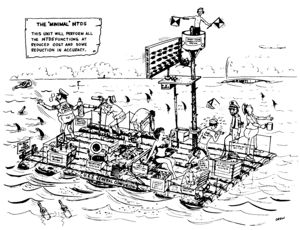
Lcdr. Joe Randolph had come out to the test site and he was standing next to the switchboard listening to our multiplexing relay clicking back and forth. “The thing seems to work,” he noted.” We could build the same electronic capability right into a new keyset central and give it more synchro input channels”.
Joe Randolph and I commuted into Main Navy on the Columbia Pike bus line. Joe’s home was a couple more miles out than my place, and we usually managed to get the same bus and get a seat together. Then our daily work started on the bus. During a couple of those trips we wrote up a specification for a new keyset central having the capability to convert 32 two-speed synchro inputs to digital format, and also to transmit a large number of incoming and outgoing on-off control and status signals. Commander Erick Swenson, by then in charge of the NTDS project, agreed to fund developing the new “keyset central multiplexer” as a future replacement for the NTDS keyset central unit. We would soon have the capability to bring a large number of analog, control, and status signals in from the weapon systems.
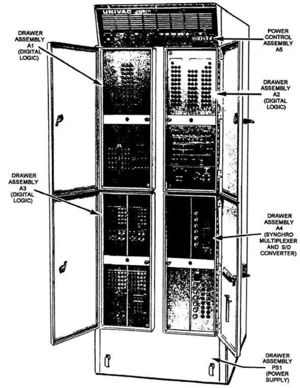
Next, we needed a way for NTDS to send just as many synchro signals out to the weapon systems, if we were to get Cdr Meyer his digital missile system testing capability. Also we had dreams of using the unit computer, or a smaller offspring, as a replacement for analog fire control computers. In the next few bus trips we wrote the contract specifications for a device that would interface with a unit computer and generate outgoing synchro signals. We called it a dynamic synchro data source (DSDS), and Cdr. Swenson agreed to fund a prototype.
A small company on Long Island was one of the respondents to our DSDS development request for proposals, and we liked their approach. We visited their factory from time-to-time to check on progress, and told them of our plans to test the prototype at the Mare Island test site. After about six months the prototype was ready for shipment, and I got a phone call from their project engineer. “Now where the hell is this Myer’s Island, we thought it was probably in Long Island Sound but we can’t find it anywhere.” When the prototype finally got to Mare Island it worked quite well, and we ordered a number of production units. Later the DSDS capability was built directly into another update of the standard NTDS keyset central.
The first three frigates of the Belknap (DLG 26) Class were under construction at Bath Iron Works at Bath , Maine. In the fall of 1963 we finished validating the automated equipment maintenance and system calibration and alignment test programs at Mare Island and delivered them to the Navy Supervisor of Shipbuilding (SUPTSHIPS) at Bath. SUPTSHIPS and the shipbuilder agreed to let the Univac engineers do a final program proof testing in Belknap’s system, in return for which the Univac engineers taught ships company and the shipbuilder how to use the new tests. We also gave them the promise that the automated tests would greatly speed up system acceptance testing and system alignment. They did, and brought over a few new converts to digital technology.
Next, Fleet Computer Programming Center, Pacific (FCPCPAC), installed and checked out Belknap’s new operational computer program. Belknap's system was similar to the service test frigates’ and ‘op program’ checkout went fairly smoothly. Next the FCPCPAC programmers checked out a version of the operational program that had the data extraction routine for our ship’s system operational readiness tests (SSORT) embedded in it. FCPC had deleted some of the track stores to make room for the data extraction capability, and off-line computer programs would be used to analyze the extracted data and print out & display graphics of the test results. Later, when Belknap embarked on her missile system qualification trials, a special Ship’s Qualification Assist Team made up of military specialists and contractor engineers directed the testing at first and then taught ships company how to use and interpret the tests during missile firings and interceptor control operations.
USS Wainwright, a Step Toward the All-Digital Ship
NTDS installation and checkout in Belknap and her follow-on sister ship Josephus Daniels (DLG 27) had gone reasonably well at Bath Iron Works, mainly because their systems were similar to the two service test frigates and surprises were few. Wainwright (DLG 28) however was going to be a horse of a different color. She would be the first ship to get both the new Weapons Direction System Mark 11 and the first production AN/SPS-48 three dimensional radar, and both the SMS and NTDS project offices felt she should get more special attention than just our periodic visits to the shipbuilder, and our riding the ships during builder’s, shakedown, and qualification trials.
We were delighted to learn that the first form of special attention was the assignment of Capt. Robert P. (Zeke) Foreman in 1964 as prospective commanding officer of Wainwright. Capt. Foreman had been head of the Terrier missile system project in the SMS Project Office, and he had become well educated in NTDS by osmosis through daily contact. Best of all, he was as determined as Lcdr. Joe Randolph was to make WDS Mk 11 work. Among other things he had been a World War II fighter director officer and knew CIC operations well.
The NTDS project officer felt Wainwright’s installation warranted an on-site project representative as had been done for the three service test ships, and Long Beach, & Enterprise. Cdr. Swenson arranged for Ensign Jeremy Goldberg, a newly minted engineering duty officer, to be assigned to the Bath, Maine, Supervisor of Shipbuilding Office to represent both NTDS and the SPS-48 radar. At first we felt a little bad about sending a young ensign up to the relatively isolated environment of Bath, Maine, but when Goldberg told us about the charms of his landlady’s daughter we decided not to feel so bad.
Lcdr. Joe Randolph had kept his WDS Mark 11 computer program module as small as promised, but he did not have direct control over the NTDS operational program into which it was to be embedded. Fleet Computer Programming Center, Pacific was in charge of the program which was primarily the same program installed in DLG 26 and 27, but with provisions to receive the WDS Mk 11 module and SPS-48 radar interface. The problem was, the Programming Center had a menu of features, all of which would more than fill Wainwright’s two computers with no room left for the weapons direction module. Many of these features were in the interceptor control module and ranged from essential to nice-to-have, and the programmers were divided concerning which of the latter features should go into the final program.
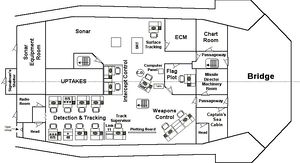
Capt. Foreman asked for the computer program documentation and spent considerable time analyzing it. From his perspective as former CIC and fighter director officer, and former Terrier system project manager as well as being the first user of the new program, he developed a listing of all program functions and the amount of memory they consumed. He ranked them in priority order from essential, to nice to have, to not really needed. Then he told the skipper of the programming center he would be pleased if they would eliminate features and functions in reverse priority order until they had room for the new weapons direction module. [Schwener William W., Evolutionary Development of the Naval Tactical Data System Operational Programs for DLG-28 Class Ships, Naval Ship Missile Systems Engineering Station, Port Hueneme, CA, 6 Nov. 1968, pp 5-6] [Foreman, Capt. Robert P., Interview with D. L. Boslaugh, 8 Sept. 1994]
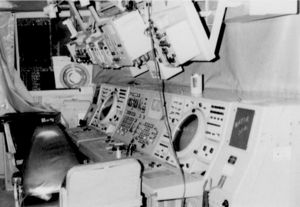
NTDS project officers both in the Bureau of Ships and OPNAV had realized from the beginning that one of the best ways to ensure the success of the project was to get the future users involved in the development; i.e. make them ‘part of the crime.’ To this end OPNAV arranged for the Bureau of Naval Personnel to send Wainwright’s future combat information center officer and its leading chief data systems technician to the Mare Island test site to help Lcdr. Jim Radja test Weapons Direction System Mark 11 and the SPS-48 radar. Thus in early 1964 Lieutenant Clifford L. Laning and Chief Michael Snodgrass found themselves with orders to the Mare Island test site.
Lt. Laning had his first brush with NTDS when he was assigned to the Operational Test and Evaluation Force as a test officer aboard the service test frigate King. Then after graduating from the U. S. naval Postgraduate School he was assigned as Wainwright’s prospective CIC officer. When Laning and Chief Snodgrass arrived at the test site the WDS Mark 11 computer program was in its first stages of integration testing, a stage where sometimes each new program correction unleashes a number of new errors. They went to work helping the programmers sleuth out causes of errors and helping to devise corrections. By the time the program had been stabilized, they had become intimately familiar with WDS Mk 11 and the AN/SPS-48 radar. Not only that, they had become well versed in the art of computer program testing and correction. This would be very useful later.
Laning and Snodgrass arrived at Bath Iron Works in mid 1965, and their first action was to set up a training course on WDS Mk 11 for their new CIC team, data system technicians, and fire control system technicians. As new precommissioning crews arrived at Bath for follow on frigates, they gave the same course to the newcomers. The Fleet Computer Programming Center, Pacific was scheduled to deliver the DLG 28’s new NTDS operational program, with WDS Mk 11 module integrated, in mid September 1965, and Laning & Ensign Goldberg worked to prepare ship’s company and shipyard engineers to help the FCPC team test and certify the new program.
After of many weeks of testing Wainwright’s computer program in FCPCPAC's DLG 28 system mockup the FCPC programers were confident it was running without errors - at their site anyway. The next step was the acid test of running it in the real ship’s system, and it was anybody's guess how many new errors would surface in the shipboard environment. It could take weeks. Center programmers made a final compile of the program on a Friday morning in mid September 1965, and tested it under stress all day in their mockup. That evening the programming team was aboard an airliner bound for Boston with reels of magnetic program tape on their laps. By early Saturday morning Wainwright sailors were loading the programs into their two computers. The testing team of Center programmers, BIW engineers, and ship’s company worked out a detailed accounting system for recording and following the progress of error correction, and round-the-clock testing began. Unbelievably, they had the program error-free in three days. [Schwener, p 5] [Laning, Capt. Clifford L., Letter to D. L. Boslaugh, 21 Jan. 1995]
USS Wainwright became a commissioned U. S. Navy ship on 8 January 1966. Next came fitting out at Boston Naval shipyard followed by shakedown cruises. Then in June she appeared off the Atlantic missile range where in the next three months her crew achieved six kills with her Terrier missiles. In the spring of 1966 the first WDS Mk 11 installation in a ‘double ended’ Terrier missile ship was completed in the nuclear powered guided missile frigate Bainbridge, and in the summer of 1967 the first WDS Mk 11 installation with a Tartar missile system was certified in the attack carrier John F. Kennedy. Lieutenant Commander Joe Randolph never had to submit his letter of resignation from the Navy. [Bureau of Ships, Technical Development Plan for the Naval Tactical Data System (NTDS)-SS 191, 1 Apr. 1964]
The reader may continue on to "THE NAVAL TACTICAL DATA SYSTEM IN COMBAT - Chapter 7 of the Story of the Naval Tactical Data System" by clicking on this link.
